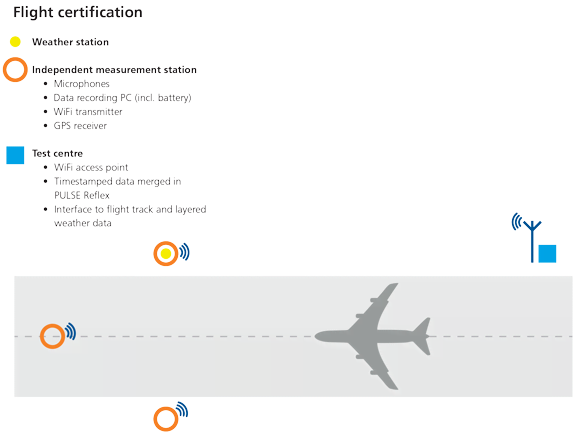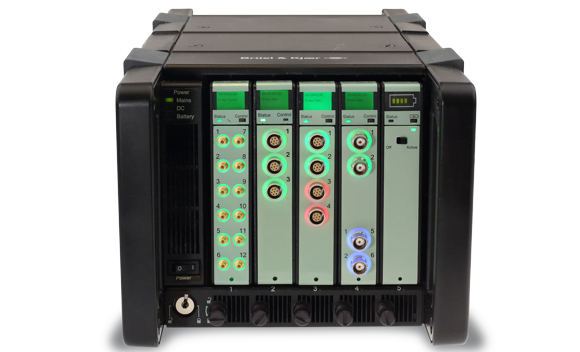Brüel & Kjær LAN-XI Data Acquisition System is highly flexible due to its modularity. These individual modules can be collected or distributed at will, allowing diverse parts of an organisation to each use some modules, and then combine them for larger tests whenever necessary.
LAN-XI
DATA ACQUISITION SYSTEM

The GPS time stamping capability built into the LAN-XI system adds another string to its bow, giving a highly accurate time signal that allows modules to be distributed far and wide, and still achieve perfect sample synchronicity. This means testers can have several, completely detached acquisition stations that each record their data to the same absolute time, so the data can be seamlessly synchronized later.
The shared, absolute time base from the GPS satellites also allows sound and vibration data to be easily correlated with data from any other source with a GPS time stamp, like weather information or plane track data in the case of flyover noise certification. This also means that cross-spectral analysis can be performed between datasets collected on independent systems, in perfect sample-synchronicity. A case could be where data measured on a flying test aircraft can be easily matched to the external acoustic information perceived on the ground.
Critically, the GPS capability allows synchronization that it is wireless. To acquire sample-synchronous data on all acquisition front-ends, traditional data acquisition configuration required a cabled synchronization mechanism. However, it is cumbersome, and often impossible, to deploy a synchronization cable between front-ends.

LEARN MORE
LAN-XI DAQ FRAMES AND
LAN-XI DAQ MODULES
A rugged data acquisition station with battery module, built-in GPS receiver, and interchangeable input /output panels for different sensors and accessories.
With independent, synchronized data acquisition stations, a whole new world of flexibility is opened up. Unlimited by the impact of cable length on signal quality, the whole data acquisition system can span large distances – making it perfect for acoustic flyover research and certification tests. Here, the completely independent acquisition stations are like nodes in a virtual network. The only cables needed on the ground are the short transducer cables, so they don’t need to cross runways, and reduce the danger of damage – such as from lightning strikes. Structural analyses of large objects, like a Ground Vibration Test, are also vastly simplified.
With LAN-XI, the absence of wires connecting each acquisition station even includes power cables, because each acquisition station can include battery modules that power not only the hardware, but also any ancillaries such as the WiFi transmitter, a weather station, or a webcam.
Data merging takes place at a central station, and for very large distances this can take place via WiFi transmission. Yet such a system doesn’t depend on perfect WiFi connectivity, or even consistent connectivity. Because the data is independently recorded at each station, and the GPS timecode is stamped into the data, these independent data sets can be merged at any time, in a post-processing environment like PULSE / BK Connect. The system will normally perform this immediately (and automatically), but when that is not possible for connectivity reasons it will simply do it later, when the connection is re-established.
Test control is also centralized in a control room from where all of the independent acquisition stations are operated – wirelessly or not – and where personnel are safe from loud noise events like sonic booms. Here, testers can start and stop measurements, and even live stream some channels to monitor actual measurements.
From this central station, the controller can remotely check the whole system. With a press of a single button, the automated calibration feature sends a signal out to every transducer in the network, to check all connections are working, and all microphones are calibrated properly. On large systems spread out over a wide area, this feature saves a huge amount of time on individually checking microphones.
The rock-steady, absolute time base provided by GPS also allows large systems to be paired, to overcome any data throughput issues. All data acquisition systems have a limit to the density of data they can handle, but by pairing completely separate systems (and then synchronizing the data), higher channel counts and bandwidths are easy to achieve.
With essentially two separate systems, data can still be harvested regardless of the factors that limit each independent system, such as computer processing capacity. Critically though, the data merging post-measurement is straightforward and automated in our data analysis software.

Iscriviti alla nostra Newsletter e ricevi le informazioni più recenti dal mondo del suoni e delle vibrazioni


